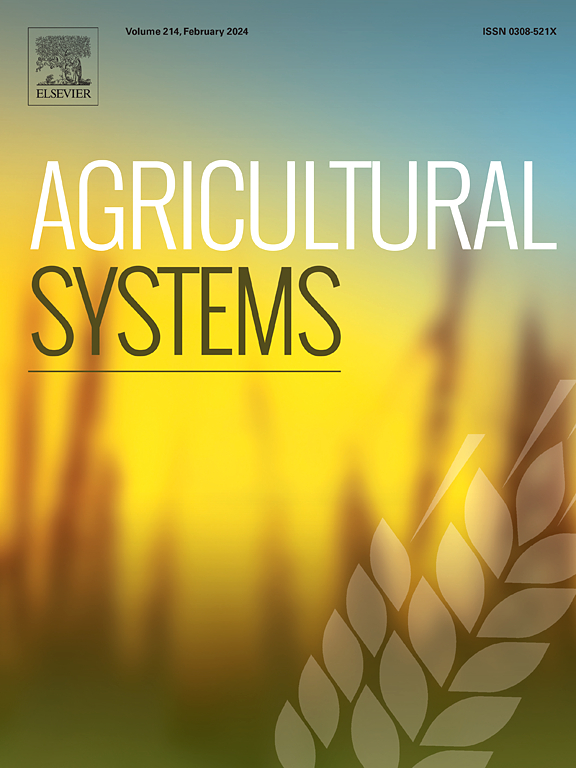Farmer seed enterprise revisited: Local seed business models in Ethiopia, Uganda, and Myanmar
IF 6.1
1区 农林科学
Q1 AGRICULTURE, MULTIDISCIPLINARY
引用次数: 0
Abstract
Context
Globally, seed business is dominated by vegetables, in sub-Saharan Africa by maize hybrids, and in South and Southeast Asia by rice and wheat. Save for informal seed systems, smallholders have few sources to turn to for quality seed of local staples, like sorghum, beans, and sweet potato. This is despite large public investments in developing improved varieties of such crops.
Objective
We revisit the debate on whether farmer seed enterprise is a viable missing middle between formal and informal seed systems and assess the business case of the model known as local seed business (LSB). To this end, we ask the questions: 1. What is the LSB niche; 2. What is the business model; 3. Is it viable, if so; 4. Under what conditions, and; 5. What is its contribution to seed availability and the agricultural economy?
Methods
We evaluate the business case for LSB through the systems perspectives of integrated seed sector development and market archetypes. Further to making inductions about the niche and business model using these concepts, we document the institutions conducive to LSBs' viability and measure LSBs' contribution in economic terms. Data were collected from case studies of the programs of Integrated Seed Sector Development (ISSD) in Ethiopia, Uganda, and Myanmar using internal documents and opinions elicited during experts' consultation.
Results and conclusions
The LSB ‘niche’ is the gap left between commercial entities and the development community intervening to improve certain households' welfare outcomes. Whilst LSBs capture small premiums compared to companies, margins are modestly positive. The presence of support – like which ISSD provided – is prerequisite for startup. The model's viability depends upon continued support in accessing affordable early generation seed and seed quality assurance services. We conclude that LSB complements rather than competes with other forms of seed entrepreneurship by broadening the products on offer, deploying new and improved varieties of crops considered commercially less interesting, and accessing harder-to-reach markets.
Significance
The systems perspective applied in our article refutes the notion that one size fits all and departs from the dichotomy that seed systems are either formal or informal. It is also an interesting case of niche innovation and strategic niche management in seed systems change. Supporting LSB is a worthwhile policy option to catalyze public investments in variety development and contribute to SDG 2: End hunger, achieve food security and improved nutrition and promote sustainable agriculture.

农民种子企业重访:埃塞俄比亚、乌干达和缅甸的当地种子商业模式
在全球范围内,种子业务以蔬菜为主,在撒哈拉以南非洲以玉米杂交品种为主,在南亚和东南亚以水稻和小麦为主。除了非正式的种子系统,小农几乎没有什么渠道可以获得高粱、豆类和甘薯等当地主食的优质种子。尽管有大量的公共投资用于开发这类作物的改良品种。目的:我们重新审视农民种子企业是否是正规和非正规种子系统之间一个可行的中间缺失的争论,并评估被称为本地种子企业(LSB)模式的商业案例。为此,我们提出以下问题:什么是LSB细分市场;2. 商业模式是什么?3. 它可行吗?如果可行;4. 在什么情况下,以及;5. 它对种子供应和农业经济的贡献是什么?方法通过综合种子部门发展和市场原型的系统视角来评估LSB的商业案例。为了进一步利用这些概念对利基和商业模式进行归纳,我们记录了有利于中小企业生存的制度,并从经济角度衡量了中小企业的贡献。数据收集自埃塞俄比亚、乌干达和缅甸种子部门综合发展(ISSD)项目的案例研究,使用内部文件和专家咨询期间征求的意见。结果和结论LSB的“利基”是商业实体和发展社区之间的差距,以改善某些家庭的福利结果。与公司相比,llb获得的溢价较小,但利润率为正。支持的存在——就像ISSD提供的那样——是启动的先决条件。该模式的可行性取决于在获得负担得起的早期代种子和种子质量保证服务方面的持续支持。我们的结论是,LSB通过扩大提供的产品,部署商业上不太感兴趣的新作物和改良作物品种,以及进入难以进入的市场,与其他形式的种子创业相补充,而不是竞争。意义在我们的文章中应用的系统观点反驳了一种方式适合所有人的观念,并脱离了种子系统是正式的还是非正式的二分法。这也是种子系统变化中生态位创新和战略生态位管理的一个有趣案例。支持LSB是一个有价值的政策选择,可以促进对品种发展的公共投资,并有助于实现可持续发展目标2:消除饥饿,实现粮食安全和改善营养,促进可持续农业。
本文章由计算机程序翻译,如有差异,请以英文原文为准。
求助全文
约1分钟内获得全文
求助全文
来源期刊

Agricultural Systems
农林科学-农业综合
CiteScore
13.30
自引率
7.60%
发文量
174
审稿时长
30 days
期刊介绍:
Agricultural Systems is an international journal that deals with interactions - among the components of agricultural systems, among hierarchical levels of agricultural systems, between agricultural and other land use systems, and between agricultural systems and their natural, social and economic environments.
The scope includes the development and application of systems analysis methodologies in the following areas:
Systems approaches in the sustainable intensification of agriculture; pathways for sustainable intensification; crop-livestock integration; farm-level resource allocation; quantification of benefits and trade-offs at farm to landscape levels; integrative, participatory and dynamic modelling approaches for qualitative and quantitative assessments of agricultural systems and decision making;
The interactions between agricultural and non-agricultural landscapes; the multiple services of agricultural systems; food security and the environment;
Global change and adaptation science; transformational adaptations as driven by changes in climate, policy, values and attitudes influencing the design of farming systems;
Development and application of farming systems design tools and methods for impact, scenario and case study analysis; managing the complexities of dynamic agricultural systems; innovation systems and multi stakeholder arrangements that support or promote change and (or) inform policy decisions.
 求助内容:
求助内容: 应助结果提醒方式:
应助结果提醒方式:


